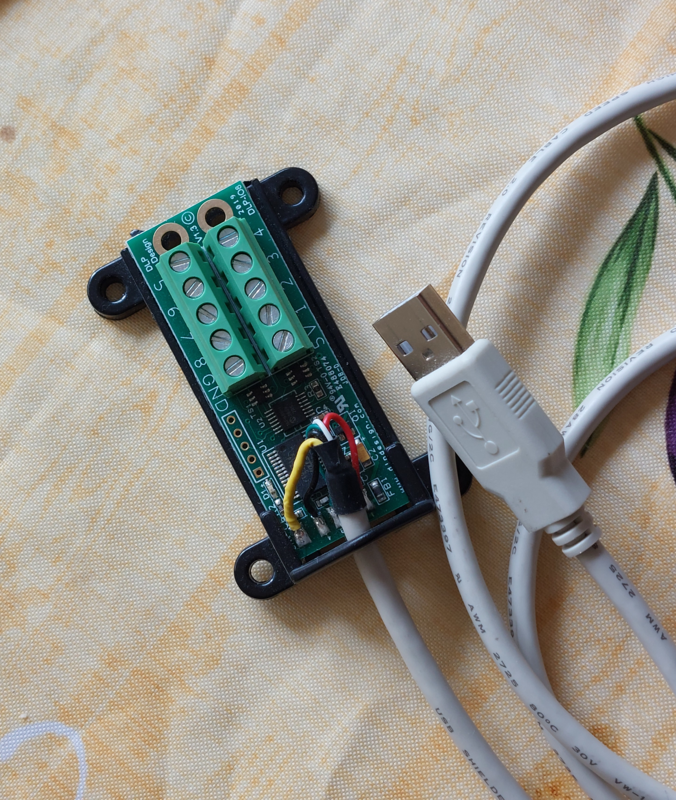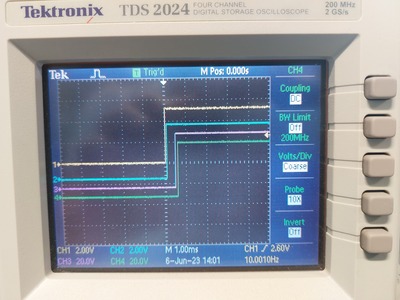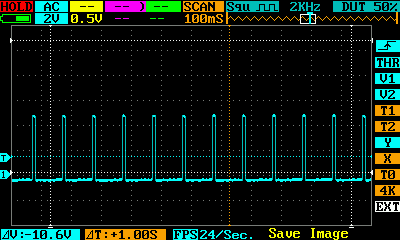Python code to control the DLP-IO8-G USB-to-TTL device.
The DLP-IO8-G is a simple USB data acquisition module which permits to receive or send TTL signals on 8 lines using a very simple serial protocol. It relies on the FTDI VCP driver which is present in the standard Linux kernel so that there is not need to install any driver: it works out of the box.
From a software point of view, it appears as a serial device which can be controlled by writing and reading characters.
For example, the following Python code, switches all data lines to 0, then 1, then 0 again, with half second delays.
from serial import Serial
from time import sleep
dlp = Serial(port='/dev/ttyUSB0', baudrate=115200) # open serial port
dlp.write(b'QWERTYUI') # sets all lines to '0'
sleep(0.5)
dlp.write(b'12345678') # sets all lines to '1'
sleep(0.5)
dlp.write(b'QWERTYUI') # sets all lines back to '0'
The following capture from a scope shows that, at the 115200 baudrate, the delay between the edges of the first and 8th line is less than 1msec.
Note: DLP design also manufactures modules with with 14 or 20 lines (see http://www.dlpdesign.com/usb/)
Here is the full list of commands:
| ASCII | Hex | Description | Return |
|---|---|---|---|
| 1 | 0x31 | Ch1 Digital Out 1 | |
| Q | 0x51 | Ch1 Digital Out 0 | |
| A | 0x41 | Ch1 Digital In | 0 or 1 |
| Z | 0x5A | Ch1 Analog In | voltage |
| 9 | 0x39 | Ch1 Temperature | |
| 2 | 0x32 | Ch2 Digital Out 1 | |
| W | 0x57 | Ch2 Digital Out 0 | |
| S | 0x53 | Ch2 Digital In | |
| X | 0x58 | Ch2 Analog In | |
| 0 | 0x30 | Ch2 Temperature | |
| 3 | 0x33 | Ch3 Digital Out 1 | |
| E | 0x45 | Ch3 Digital Out 0 | |
| D | 0x44 | Ch3 Digital In | |
| C | 0x43 | Ch3 Analog In | |
| - | 0x2D | Ch3 Temperature | |
| 4 | 0x34 | Ch4 Digital Out 1 | |
| R | 0x52 | Ch4 Digital Out 0 | |
| F | 0x46 | Ch4 Digital In | |
| V | 0x56 | Ch4 Analog In | |
| = | 0x3D | Ch4 Temperature | |
| 5 | 0x35 | Ch5 Digital Out 1 | |
| T | 0x54 | Ch5 Digital Out 0 | |
| G | 0x47 | Ch5 Digital In | |
| B | 0x42 | Ch5 Analog In | |
| O | 0x4F | Ch5 Temperature | |
| 6 | 0x36 | Ch6 Digital Out 1 | |
| Y | 0x59 | Ch6 Digital Out 0 | |
| H | 0x48 | Ch6 Digital In | |
| N | 0x4E | Ch6 Analog In | |
| P | 0x50 | Ch6 Temperature | |
| 7 | 0x37 | Ch7 Digital Out 1 | |
| U | 0x55 | Ch7 Digital Out 0 | |
| J | 0x4A | Ch7 Digital In | |
| M | 0x4D | Ch7 Analog In | |
| [ | 0x5B | Ch7 Temperature | |
| 8 | 0x38 | Ch8 Digital Out 1 | |
| I | 0x49 | Ch8 Digital Out 0 | |
| K | 0x4B | Ch8 Digital In | |
| , | 0x2C | Ch8 Analog In | |
| ] | 0x5D | Ch8 Temperature | |
| ` | 0x60 | set ASCII mode | |
| \ | 0x5C | set BINARY mode | |
| L | 0x4C | set °F | |
| ; | 0x3B | set °C | |
| ' | 0x27 | Ping | Q (0x51) returned if DLP-IO8 is ok |
A full description of the device is available at http://www.ftdichip.com/Support/Documents/DataSheets/DLP/dlp-io8-ds-v15.pdf
To use it under Python, you need to install pyserial:
pip install pyserial
Under Linux, add yourself to the tty and dialup groups:
sudo usermod -a -G tty [yourlogin]
sudo usermod -a -G dialout [yourlogin]
Once plugged, to determine the serial port the dlp-io8-g is attached to, type the
command dmesg in a Terminal. You should get something like::
[ 5128.109725] usbcore: registered new interface driver usbserial_generic
[ 5128.109730] usbserial: USB Serial support registered for generic
[ 5128.112142] usbcore: registered new interface driver ftdi_sio
[ 5128.112148] usbserial: USB Serial support registered for FTDI USB Serial Device
[ 5128.112175] ftdi_sio 1-1:1.0: FTDI USB Serial Device converter detected
[ 5128.112190] usb 1-1: Detected FT232RL
[ 5128.113130] usb 1-1: FTDI USB Serial Device converter now attached to ttyUSB0
The last line tells you that the device is at /dev/ttyUSB0.
from serial import Serial
dlp = Serial(port='/dev/ttyUSB0', baudrate=115200) # open serial port
dlp.write(b'QWERTYUI') # set all lines to '0'
dlp.write(b'12345678') # set all lines to '1'
ON1 = b'1'
ON2 = b'2'
ON3 = b'3'
ON4 = b'4'
dlp.write(ON1 + ON2 + ON3 + ON4)
OFF1 = b'Q'
OFF2 = b'W'
OFF3 = b'E'
OFF4 = b'R'
dlp.write(OFF1 + OFF2 + OFF3 + OFF4) import time
import serial
dlp = serial.Serial(port='/dev/ttyUSB0', baudrate=115200) # open serial port
print(dlp.name) # check which port was really used
dlp.write(b'`') # switch to ascii mode
start = time.perf_counter()
previous_state = '2'
while True:
dlp.write(b'A') # request to read line 1
state = dlp.read(3).decode('utf-8')
if state[0] != previous_state[0]:
print(time.perf_counter() - start, state[0])
previous_state = state #! /usr/bin/env python3
""" Generate a square wave on pin1 of DLP-IO8-G """
from time import perf_counter
from serial import Serial
dlp = Serial(port='/dev/ttyUSB0', baudrate=115200) # open serial port
# byte codes to control line 1:
ON1 = b'1'
OFF1 = b'Q'
# number of periods
NPERIODS = 1000
# Timing of the square wave
TIME_HIGH = 0.010 # 10ms pulse
TIME_LOW = 0.090 # send every 100ms
PERIOD = TIME_HIGH + TIME_LOW
onset_times = [ (PERIOD * i) for i in range(NPERIODS) ]
i = 0
while i < NPERIODS:
if i == 0:
t0 = perf_counter()
# wait until the start of the next period
while perf_counter() - t0 < onset_times[i]:
None
dlp.write(ON1)
# busy wait for 'TIME_HIGH' seconds. This should be more accurate than time.sleep(TIME_HIGH)
t1 = perf_counter()
while perf_counter() - t1 < (TIME_HIGH):
None
dlp.write(OFF1)
i = i + 1
print(f"\r{i:4d}", end='')
time.sleep(TIME_LOW)
print()
print(f'{NPERIODS} periods of {PERIOD} seconds')
print('Total time-elapsed: ' + str(perf_counter() -t0))
dlp.close() # close the portHere is the result on an oscilloscope:


